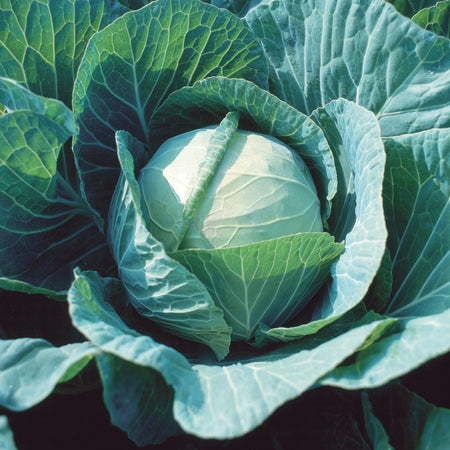65 days. Farao's deep green heads are nicely nestled in its protective outer leaves. Farao will remain in the garden for a long time without splitting. Once cut, the heavy 3-4 pound heads reveal a dense interior with a crisp mellow peppery taste, which is great in stir-fry.
Brassica oleracea, Capitata Group Cabbage holds the esteemed position of the vegetable that contains the least amount of fat per serving. As an excellent source of vitamin C and antioxidant phytonutrients, cabbage is a great defender against cancer. Red cabbage is rich in anthocyanins, which have anti-inflammatory properties.
Days to maturity are calculated from date of transplanting; add 25-35 days if direct seeding.
Culture
• Sudden temperature changes or high applications of fertilizer may result in poor head shape and reduced yields
• Consistent and even watering is necessary
Direct Sowing
• Sow March—June
• Not recommended for fall plantings
Transplanting
• Start indoors 4-6 weeks before anticipated transplant date
• Work in 1/4-1/2 cup of TSC's Complete fertilizer around each plant
• For a fall crop: start May—July for transplanting June—August
Insects & Diseases
• Common insects: See Brassica Insect Information below
• Disease prevention: 5-7 year crop rotation
Harvest & Storage
• Early types: Mature fast and burst quickly, so they must be harvested promptly
• Later types: Hold in the field longer
• When cutting heads from stems, include 2 or 3 wrapper leaves to protect against bruising
• Over-mature heads can split, especially if they are exposed to moisture fluctuations
• Late storage types will keep for up to 6 months when kept at 36°F and at 100% relative humidity; early types will store 1-2 months
Brassica Insect Information
Aphids: Control aphids with ladybugs or a hard spray of water or Pyrethrin. Also, select varieties that mature later in the season when aphid populations decline.
Cabbage worms, loopers, and root maggots: The first sign of cabbage worms will be off-white butterflies fluttering near the plants. They lay their yellowish-colored eggs on the undersides of leaves, which hatch into caterpillars that can cause severe root and head damage. To control light infestations, spray plants with Bacillus thuringiensis (B.t.). For heavy infestations, bait cabbage worms by mixing wheat bran into a B.t. solution. Add 1 tablespoon of molasses. Broadcast the bran mixture around the base of plants. Reapply as necessary. Using Reemay or Summer Insect Barrier can also provide control.
Flea beetles: Flea beetles chew tiny pinholes in leaves. Early control is essential to minimize the damage. Spray infected plants with Pyrethrin. Using floating row covers such as Summer Insect Barrier can also provide control.
Symphylans: In some areas of the US, symphylans (also known as garden centipede) can severely impede the plant growth of many crops. Only 1/4 inch long, white, and very active, they eat the root hairs of developing plants. Using larger transplants helps reduce damage. Contact your local county extension agent if you suspect you have a problem.
KEY TO CABBAGE DISEASE RESISTANCE AND TOLERANCE
HR indicates high resistance.
IR indicates intermediate resistance.
F | Fusarium Wilt
YR | Fusarium Yellows
Brassica oleracea, Capitata Group Cabbage holds the esteemed position of the vegetable that contains the least amount of fat per serving. As an excellent source of vitamin C and antioxidant phytonutrients, cabbage is a great defender against cancer. Red cabbage is rich in anthocyanins, which have anti-inflammatory properties.
Days to maturity are calculated from date of transplanting; add 25-35 days if direct seeding.
Culture
• Sudden temperature changes or high applications of fertilizer may result in poor head shape and reduced yields
• Consistent and even watering is necessary
Direct Sowing
• Sow March—June
• Not recommended for fall plantings
Transplanting
• Start indoors 4-6 weeks before anticipated transplant date
• Work in 1/4-1/2 cup of TSC's Complete fertilizer around each plant
• For a fall crop: start May—July for transplanting June—August
Insects & Diseases
• Common insects: See Brassica Insect Information below
• Disease prevention: 5-7 year crop rotation
Harvest & Storage
• Early types: Mature fast and burst quickly, so they must be harvested promptly
• Later types: Hold in the field longer
• When cutting heads from stems, include 2 or 3 wrapper leaves to protect against bruising
• Over-mature heads can split, especially if they are exposed to moisture fluctuations
• Late storage types will keep for up to 6 months when kept at 36°F and at 100% relative humidity; early types will store 1-2 months
Brassica Insect Information
Aphids: Control aphids with ladybugs or a hard spray of water or Pyrethrin. Also, select varieties that mature later in the season when aphid populations decline.
Cabbage worms, loopers, and root maggots: The first sign of cabbage worms will be off-white butterflies fluttering near the plants. They lay their yellowish-colored eggs on the undersides of leaves, which hatch into caterpillars that can cause severe root and head damage. To control light infestations, spray plants with Bacillus thuringiensis (B.t.). For heavy infestations, bait cabbage worms by mixing wheat bran into a B.t. solution. Add 1 tablespoon of molasses. Broadcast the bran mixture around the base of plants. Reapply as necessary. Using Reemay or Summer Insect Barrier can also provide control.
Flea beetles: Flea beetles chew tiny pinholes in leaves. Early control is essential to minimize the damage. Spray infected plants with Pyrethrin. Using floating row covers such as Summer Insect Barrier can also provide control.
Symphylans: In some areas of the US, symphylans (also known as garden centipede) can severely impede the plant growth of many crops. Only 1/4 inch long, white, and very active, they eat the root hairs of developing plants. Using larger transplants helps reduce damage. Contact your local county extension agent if you suspect you have a problem.
KEY TO CABBAGE DISEASE RESISTANCE AND TOLERANCE
HR indicates high resistance.
IR indicates intermediate resistance.
F | Fusarium Wilt
YR | Fusarium Yellows
